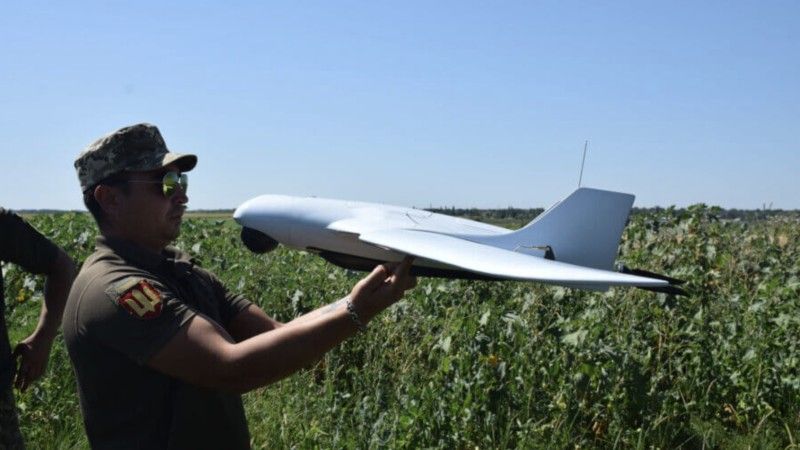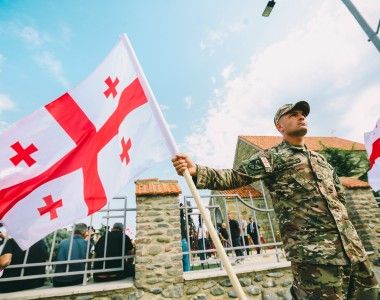How Ukraine Is Using UAVs to Defend the Country? [INTERVIEW]

Photo. Athlon Avia
The role of Electronic Warfare is very significant – not only jamming, but also SIGINT is very important, because it serves as a sort of early warning, and it is impossible for the enemy to detect the passive SIGINT systems - as Yurii Bosykh, Head of Unmanned Aviation, National Guard of Ukraine told Defence24.com in an interview.
Jakub Palowski, Defence24.pl: Ukraine has been fighting against a large scale Russian aggression for more than three months now, while the war is lasting since 2014 year. On the first day of full-scale war, National Guard supported repelling a Russian attack on Hostomel airport, which is situated close to Ukraine capital, Kyiv. This seems to be crucial to overall Ukrainian defensive effort. Could you tell me what were the factors that enabled Ukraine to successfully defend against an attack on the Hostomel airport?
Yurii Bosykh, Head of Unmanned Aviation, National Guard of Ukraine: Firstly, the National Guard has a brigade, that is permanently stationed close to the Hostomel airport. This is one of the reasons why our forces contributed to the defence of the airport.
I would like to highlight Russians had developed a concept for a very fast attack on Ukraine capital. They decided to use a large number of helicopters, which would move very fast and very low, to deploy paratroopers and secure the airstrip. Those paratroopers would then be followed by more paratroop forces sent by Il-76 transport aircraft, which would land at Hostomel. We need to remember that if paratroopers are deployed directly on the airstrip, without parachuting them, the transport aircraft can take as many as twice as many troops. That was the reason Russian forces had wanted to capture the airport and start offensive operations against our capital from the airport.
Near Kyiv there is also Vasylkiv aiport, where Ukrainian military interceptor aircraft are based, and this was the second point of interest for the Russian aggressors. It has a similar airstrip to the one that is in Hostomel. And main Kyiv city airport in Boryspil, situated 20 km from the city, has two very long airstrips, capable of taking various transport and passenger aircraft. It was, however, very heavily defended by the Air Defence of the Ukrainian Armed Forces, so it was not possible to conduct a helicopter assault there.
I understand that you were not able to provide such a high level of air defence to all the airports, including Hostomel.
Yes, the capacity of our Air Defence is limited, and we were not able to cover all the objects we wanted. However, we have managed to repel the Russian attack after it had landed in Hostomel, with a large participation of the National Guard. After the failed attempt of helicopter assault, Russia had conducted a land operation to capture the airport, but it was not able to use the airstrip anymore.
Read more
Ukraine has various branches of the Armed Forces – Land Force, Air Force, Navy, as well as the Territorial Defence Force and last but not least the National Guard. It seems that all those formations are cooperating very effectively. How is it possible?
Let me start with describing the peacetime organization. The National Guard of Ukraine, as well as the National Police and the State Border Service are normally supervised to the Ministry of Internal Affairs. In the wartime, the National Guard changes its attribution to the Ground Forces of the Armed Forces of Ukraine. So, we have started working with the Ground Forces, we are receiving orders from the Ground Forces Command.
But did you exercise the change of attribution to the Ground Forces in peacetime?
Yes, in 2020 we have conducted a training together with the Armed Forces, to learn how to cooperate. That training did show some of the gaps in communication, sharing and understanding the information as well as the order generation. I was in charge of the inspection team back then. We were analyzing the experiences. In my section, I found some "lessons learned", which later were implemented to improve the coordination between the Ground Forces and the National Guard.
Let me move to your area of specialty. Before the large-scale invasion started, Ukraine was procuring the Unmanned Aerial Vehicles from many sources, including the Ukrainian industry, like the Skyeton, Fury, Leleka, Mara, Sparrow system, but also Polish FlyEye and Turkish systems. Now even civilian quadrocopters are being used. How did Ukraine manage to integrate all those different systems effectively?
This is a big issue for us. Since 2014, one of the subdivisions of the General Staff of the Armed Forces started creation of a online platform, Battle Management System. The main idea was to have situational awareness for the General Staff. The system is based on the most modern NATO database. The system was centralized, with no replications. It also has very simple human interface, and it is understandable for various service ranks: from soldiers in the field from general.
We also started implementing various interfaces to the system, so that we can use information from many sources, including – partially – many UAVs. Since 2014, that system had its good and bad times, because some of the competitors wanted to create different systems – distributed, with replication between nodes.
Additionally, from time to time, the military did not to work with that BMS because it had some personal issues with the designers of the system. However, the designers team had very good results in NATO assessments. During an exercise, the Canadian Red team tried to access the system from both inside and outside and gain some administrative roles, and it turned out that the system is pretty stable, solid. That gave us the possibility to work with that system on a larger scale.

Photo. Flytronic
To what extent is it used now?
For now, its use is still somehow limited, because we only see the enemy forces positions from our reconnaissance. We are not yet allowed to use it as a "Blue Force Tracker", to see positions of friendly forces, because it is limited by law. The system has not passed the certification of the special services for use in "Blue Force Tracking", and that is why it has only enemy forces records.
Since the beginning of the large-scale war, we have invited a large number of users to use that system. That includes the Electronic Warfare Forces, Radar Reconnaissance, UAV Reconnaissance, as well the volunteers and Territorial Defence Forces that have passed appropriate checks. We also created special Telegram booth for citizens, where we can receive information from civilians on the captured areas.
After we receive the information from civilians or volunteers, for example flying their own drones, that information is verified by the military intelligence. For instance, by conducting the flight of the military UAV. The planning procedures are based on the NATO principles. The areas of interest are being put on the map, so the many reconnaissance teams can see it and they are able to conduct preliminarily planned operations.
The system was recognized by the General Staff, and it is starting to implement it to everyday practice. It is good for us that the system is already deployed, and it is very easy to connect with various systems. It is an open system, but you need to pass special procedure of authorization to connect to the system. You need only a browser.
Read more
Can you use a civilian device to access the system, or are only military computers allowed?
Yes. It can be used at mobile phone. Since the February full scale invasion has started, many of the military communications nodes were physically destroyed by the Russian forces, which used cruise missiles and ballistic missiles. Some of them are fixed infrastructure, so they were in Russian target databanks, they could be included in those target databanks even before the full-scale invasion.
What are now your major requirements, regarding the capabilities needed to counter Russian aggression?
We need basically everything – both equipment of various types and personnel. But I would focus on the IT staff, qualified staff. People who understand NATO protocols, how they work and how should they do depending on their present role.
In the past we were in the process of harmonizing procedures, but that process was not completed until the war started. We still have some old military standards coming from the old Soviet era, and those standards do not meet requirements of current Army. We need to change that across the whole force structure.
So as a first step, those people need to understand how the NATO warfare processes are working. The second stage is getting rid of the old standards and creating as well as implementing new procedures across the Armed Forces.

Photo. KRET/kret.com
Your formal position is mainly associated with the UAVs, but I see we are talking about the entire targeting cycle. Does that include also Electronic Warfare?
Yes, and I am also responsible for the Electronic Warfare systems. It is difficult to find trained officers that understand how those systems work and how should be employed. Some of them are young officers. However, after the war started, we have started training more officers in this area and we have also gathered many signatures of the signals systems of enemy UAVs and radars.
We disseminate this information among the Army, Ground Forces who have the same signal intelligence tools. Now, everyone that is working in this field has the same signature database. Now, the process is taking almost automatically.
For instance, when you receive the signal of a Russian Orlan-10 UAV, you know it is an artillery coordinating UAV. So, it is very dangerous, we need to do something, we need to locate it immediately. On the other hand, we have not yet gained enough experience to locate all the small saboteurs groups, but they are very dangerous and it is vital to locate them and work with the mortar subdivisions to engage them immediately. The American artillery has already worked it out in such a way that it may take even less than 30 seconds from target detection to engagement. The role of Electronic Warfare is very significant – not only jamming, but also SIGINT is very important, because it serves as a sort of early warning, and it is impossible for the enemy to detect the passive SIGINT systems.
To what extent do the Ukrainian Electronic Warfare Forces cooperate with the Unmanned Aerial Vehicles?
The cooperation is very important. Once we detect and classify a suspicious activity in the electromagnetic spectrum and classify it depending on signature, it is possible to take a second step, for example a reconnaissance flight, to gather more specific information on the threat. And those flights are planned in coordination with the SIGINT and Electronic Warfare forces.
We try to avoid flying the UAVs as "free hunting", because Russia has large quantity powerful Electronic Warfare systems, based on big trucks, which could threaten to jam UAVs. So, the Ukrainian forces need to use special tactics.
The best practice would be four us to have a large number of specially designed UAVs that are hardened, can operate under jamming, in GPS-denied environment and have some autonomy in operation. However, there are limitations, and the very high accuracy Inertial Measurement Units (IMUs) which are needed for such drones cost a lot and have certain weight, so they cannot be used on the small drones, only on the larger like Bayraktar which we have in small number. We still need to use more small drones, with limitations in their size, weight and power and we are already looking on some other solutions regarding navigation. We are waiting for the results of ongoing testing of those solutions.
Thank you very much for the meeting and for the conversation.






